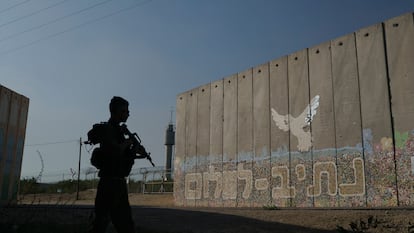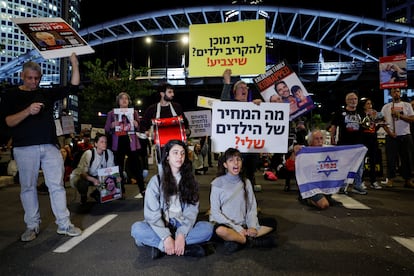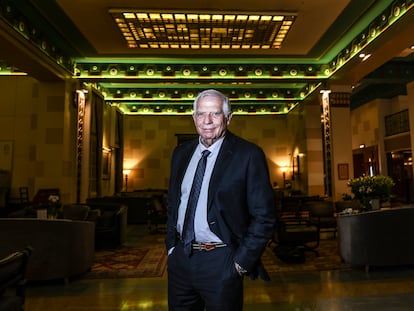Israel and Hamas agree to four-day ceasefire and exchange of hostages for prisoners
The pact, which includes the entry of hundreds of trucks with aid supplies into the Strip, represents the greatest diplomatic milestone of the war

After 47 days of war, diplomatic maneuvering, and pressure from the families of the hostages, Israel and Hamas have reached an agreement whereby the Islamist militia will release 50 of the nearly 240 people it kidnapped during its October 7 attack, in exchange for a four-day truce, the entry of hundreds of trucks of humanitarian aid into Gaza and the release of 150 Palestinian prisoners. In both cases, those released will be women and children. The agreement, brokered by Qatar, the United States and Egypt, is the most important diplomatic milestone since the conflict broke out, but it is far from signifying an end to the war. “We will not stop after the ceasefire,” Israeli Prime Minister Benjamin Netanyahu has stressed, to quell fears in his government that international pressure will make the temporary cessation of hostilities definitive.
The implementation of the agreement, confirmed by both Israel and Hamas, will be carried out in phases: some 12-13 hostages will be handed over and around 40 Palestinian prisoners released per day. When the four-day truce ends, “the release of every additional 10 hostages will result in one additional day in the [humanitarian] pause,” the Israeli government said in a statement, which does not outline the concessions made and insists that “the Government of Israel, the IDF and the security services will continue the war in order to return home all of the hostages, complete the elimination of Hamas and ensure that there will be no new threat to the State of Israel from Gaza.” According to Netanyahu, the pact also includes allowing the Red Cross to visit the remaining hostages and provide them with medical care.
Hamas also confirmed the agreement in a statement. It puts the release at 150 women and children (mainly from the West Bank and East Jerusalem) and notes that it includes an Israeli commitment not to attack or arrest a single person anywhere in Gaza during the truce.
It also stipulates the entry into the Strip of hundreds of trucks carrying humanitarian aid, medicine, and fuel. Israel has maintained a “complete siege” of Gaza since the October 7 attacks, allowing only a tiny fraction of the required aid to enter from Egypt and only for the southern part of the enclave, where most of the 1.1 million inhabitants displaced from the north have sought refuge from the Israeli assault. Last week, Israel gave the green light for the entry of two trucks a day of fuel to prevent the accumulation of sewage from generating a health crisis that could also affect its soldiers, force a halt to the war, or even end up crossing into Israel.
An official Israeli source quoted by local media stated that the 50 hostages to be released are all Israeli nationals: 30 minors, eight mothers and 12 other women. If Hamas releases more hostages of other nationalities, it will be within the framework of an agreement with their respective countries. Before the current war Israel held some 5,300 Palestinian prisoners, but the wave of repression in the West Bank and East Jerusalem has raised that number to around 8,000, according to the estimates of the Palestinian National Authority (PNA) minister in charge of prisoners, Qadura Fares.

An unprecedented agreement
Like many things since October 7, the agreement between Israel and Hamas is unprecedented. Just as that day was the deadliest in Israel’s 75-year history, with more than 1,200 people killed, and the subsequent air strikes in Gaza are unparalleled — Israel dropped as many bombs in the first few days of the war as the United States dropped in Afghanistan in a year — and 69% of those who have lost their lives in the conflict are children and women, Israel has never received so many hostages at the same time. The price for the releases is also much lower than in previous exchanges, with a ratio of one hostage for every three prisoners. Hamas had previously managed to secure the release 1,000 prisoners in exchange for a single Israeli soldier, Guilad Shalit, who was returned in 2011 after being held in Gaza for five years. Among those in the exchange was Yahia Sinwar, who would eventually become the Hamas leader who masterminded the October 7 attacks.
After weeks of negotiations, the pact ultimately hinged only on the Israeli government’s approval, as Qatari Foreign Ministry spokesman Majed Al-Ansari made clear on Tuesday night before the executive meeting began. “It is a difficult decision, but it is the right one,” Netanyahu said. The Israeli prime minister has had to strike a balance between accusations of inaction on the part of the hostages’ families, who demand that their release be the government’s top priority, and the most nationalist and right-wing elements of his government, who do not want any restrictions on Israel’s actions and demand forcefulness in Gaza, where over 14,000 Palestinians have been killed and entire neighborhoods reduced to rubble. While the government debated, dozens of Israelis pressed for an agreement in front of the headquarters of the Israel Defense Forces in Tel Aviv, carrying banners such as “Agreement now!” or “What is the price of my son?”

Although the ultra-right had announced its opposition to the deal and some ministers among Netanyahu’s Likud party harbored doubts, only three of the 38 members of the Cabinet voted against: the ministers of Jewish Power, the formation of the head of National Security, Itamar Ben Gvir. The pact does not require parliamentary endorsement, but, by law, if any of the Palestinians released from prison have committed blood crimes the relatives of their victims can appeal to the Supreme Court, which would delay the process by 24 hours.
One of the elements that delayed the approval until 3 a.m. local time was the number of minors included. Hamas argues that, in the current chaos of an overrun Gaza split in two, it has no ability to know exactly where they all are, nor to guarantee their handover without a ceasefire, which opens the door to the release of the other 10 children. Most of the hostages are held by Hamas, but Islamic Jihad, other smaller armed groups and even civilians are holding dozens more.
The other thorny issue was assurances that Israel will continue to obtain intelligence during the six hours a day for which, according to the agreement, drones will only be allowed to fly over the north of the Strip. Several ministers asked the security leadership for this guarantee, according to national public television. Hours before the pact was confirmed, Israeli army spokesman Daniel Hagari clarified that it would not affect the goal of eliminating Hamas politically and militarily. “We will know how to restore our operational achievements,” he noted.
Sign up for our weekly newsletter to get more English-language news coverage from EL PAÍS USA Edition
Tu suscripción se está usando en otro dispositivo
¿Quieres añadir otro usuario a tu suscripción?
Si continúas leyendo en este dispositivo, no se podrá leer en el otro.
FlechaTu suscripción se está usando en otro dispositivo y solo puedes acceder a EL PAÍS desde un dispositivo a la vez.
Si quieres compartir tu cuenta, cambia tu suscripción a la modalidad Premium, así podrás añadir otro usuario. Cada uno accederá con su propia cuenta de email, lo que os permitirá personalizar vuestra experiencia en EL PAÍS.
¿Tienes una suscripción de empresa? Accede aquí para contratar más cuentas.
En el caso de no saber quién está usando tu cuenta, te recomendamos cambiar tu contraseña aquí.
Si decides continuar compartiendo tu cuenta, este mensaje se mostrará en tu dispositivo y en el de la otra persona que está usando tu cuenta de forma indefinida, afectando a tu experiencia de lectura. Puedes consultar aquí los términos y condiciones de la suscripción digital.
More information
Archived In
Últimas noticias
Most viewed
- David King, chemist: ‘There are scientists studying how to cool the planet; nobody should stop these experiments from happening’
- Reinhard Genzel, Nobel laureate in physics: ‘One-minute videos will never give you the truth’
- Mexico completes its trade shift with the entry into force of tariffs on China and countries without trade agreements
- Oona Chaplin: ‘I told James Cameron that I was living in a treehouse and starting a permaculture project with a friend’
- Sinaloa Cartel war is taking its toll on Los Chapitos











































